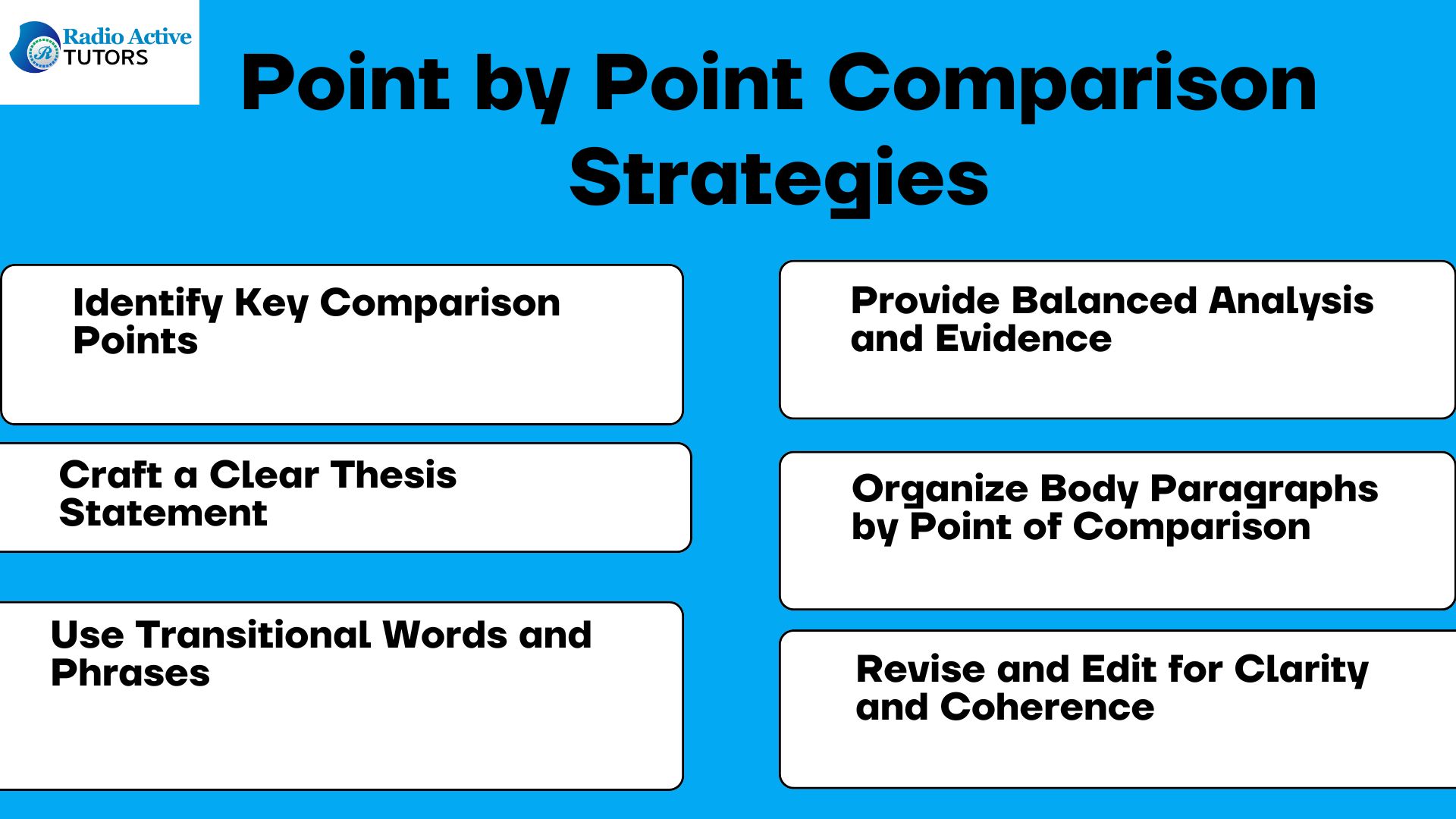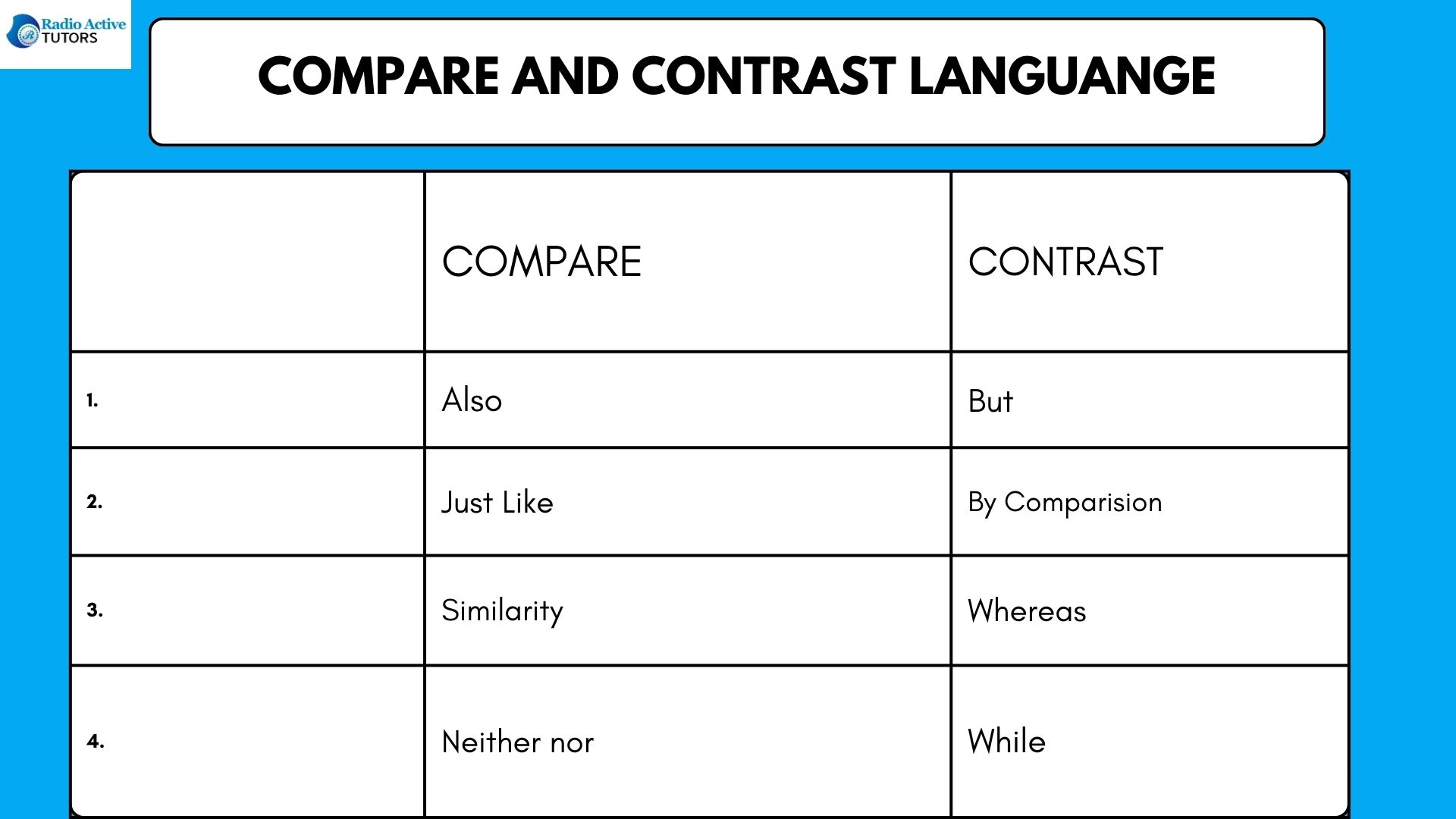I. Introduction
- Hook
- Definition of Elemnts
- Thesis Statement
II. Body Paragraph; Point by Point Comparison
A. Point 1
- Introduction of the Point
- Comparision of Element 1
- Comparision of Element 2
- Analysis
B. Point 2
- Introduction of the Point
- Comparision of Element 1
- Comparison of Element 2
- Analysis
C. Point 3
- Introduction of the Point
- Comparision of Element 1
- Comparision of Element 2
- Analysis
III. Conclusion
- Restate Thesis
- Synthesis
- Final Thoughts
Writing a compare and contrast essay is an essential skill that allows you to explore the similarities and differences between two or more subjects.
One of the most effective strategies for organizing such an essay is the point-by-point method.
This approach ensures a detailed and balanced analysis by examining each point of comparison individually for both subjects.
This comprehensive guide will walk you through the point-by-point method, including crafting a strong thesis statement, the use of transitional words and phrases, and employing Venn diagrams for organization.

I. Introduction
The introduction of a compare and contrast essay sets the stage for the entire piece. It should capture the reader's interest, clearly define the subjects being compared, and present a concise thesis statement.
To engage your readers from the start, begin with a compelling hook.
This could be an intriguing fact, a provocative question, or a relevant anecdote.
For example, if you are comparing solar energy and wind energy, you might open with an impactful statistic like, “Did you know that by 2050, renewable energy sources such as solar and wind are expected to provide over 70% of the world’s electricity?”
Such a hook not only grabs attention but also highlights the importance of the topic.
Definition of Element 1:
Start by defining the first element of your comparison. In the case of comparing solar energy with wind energy, begin with solar energy.
Solar energy is harnessed from the sun’s radiation through photovoltaic cells or solar thermal systems.
These systems convert sunlight into electrical energy or thermal energy, respectively.
Explain the process of how solar panels capture sunlight and convert it into electricity, and describe their common applications, including powering homes, businesses, and even satellites in space.
Definition of Element 2:
Next, define the second element of your comparison. For instance, describe wind energy. Wind energy is generated by converting the kinetic energy of wind into electrical power using wind turbines.
These turbines consist of blades that spin when wind passes over them, which then drives a generator to produce electricity.
Highlight how wind energy is utilized in various settings, from large-scale wind farms to smaller, residential turbines.
The thesis statement is a crucial element of the introduction. It should clearly present the main points of comparison and indicate the use of the point-by-point method for the essay.
For instance: “While both solar and wind energy are critical to the future of renewable energy, they differ significantly in terms of efficiency, cost, and environmental impact.
This essay will use the point-by-point method to provide a detailed comparison of these two energy sources, examining their respective advantages and challenges.”
II. Body Paragraphs: Point-by-Point Comparison

The body of your essay is where the point-by-point method excels, allowing for a detailed examination of each comparison point for both subjects. Learn more on comparison essay here!
Point 1: Efficiency
Efficiency is a vital factor when evaluating energy sources, as it measures how effectively an energy source converts its primary resource into usable power.
Efficiency impacts the performance and practicality of each energy source.
Discuss the efficiency of solar energy. Modern solar panels generally have an efficiency range between 15% and 22%.
This means that solar panels convert 15% to 22% of the sunlight they capture into electrical energy.
Factors such as the angle of installation, geographical location, and weather conditions play a significant role in determining the efficiency of solar panels.
For example, panels located in areas with ample sunshine tend to perform better compared to those in regions with frequent cloud cover or precipitation.
Compare this with wind energy efficiency. Wind turbines operate at an efficiency range of approximately 30% to 45%.
The efficiency of wind turbines is influenced by wind speed, turbine design, and other factors.
Unlike solar panels, wind turbines can generate electricity around the clock, provided there is sufficient wind.
However, their efficiency is subject to variability based on changing wind conditions, which can differ from day to day and season to season.
In your analysis, discuss the implications of these efficiency differences. Solar energy provides a stable source of power in sunny regions but is less effective during cloudy weather or nighttime.
Wind energy, while capable of generating power continuously, relies on variable wind patterns.
Use transitional phrases such as “similarly,” “in contrast,” and “on the other hand” to connect your points and guide the reader through the comparative analysis.
Point 2: Cost
Cost is an essential factor when evaluating energy sources, encompassing both initial investment and ongoing operational expenses.
It affects the overall feasibility and attractiveness of each energy source.

Detail the costs associated with solar energy.
The initial investment for solar energy includes the cost of purchasing solar panels, inverters, mounting systems, and installation.
Although the upfront costs can be high, various financial incentives such as tax credits, rebates, and grants can help reduce these expenses.
Over time, solar panels tend to offer significant savings due to low maintenance costs and reduced electricity bills.
Compare these costs with those of wind energy.
The installation of wind turbines involves substantial initial expenses, including the cost of the turbines, installation, and land acquisition.
Additionally, maintenance costs for wind turbines can be higher compared to solar panels due to their mechanical components and the need for periodic repairs.
Similar to solar energy, wind energy projects may benefit from subsidies and financial incentives that can help offset initial costs.
Analyze the financial implications of each energy source.
Solar energy often requires a larger initial investment but can lead to long-term savings through reduced electricity costs and low maintenance expenses.
Wind energy also involves significant upfront costs but may offer financial advantages through subsidies and the potential for large-scale energy production.
Use phrases like “in contrast,” “cost-effectively,” and “whereas” to highlight the differences and provide a comprehensive view of the financial aspects.
Point 3: Environmental Impact
The environmental impact of each energy source is a critical consideration for assessing sustainability.
This includes evaluating land use, effects on wildlife, and greenhouse gas emissions.
Examine the environmental impact of solar energy. Large-scale solar installations require substantial land area, which can lead to habitat disruption if not managed properly.
Additionally, the production of solar panels involves resource extraction and energy use, which may have environmental consequences.
However, once installed, solar panels produce clean energy with minimal operational impact.
Advances in recycling technologies are also helping to address concerns related to the disposal of end-of-life panels.
Compare this with the environmental impact of wind energy.
Wind turbines also require land for installation, and their presence can affect local wildlife, including birds and bats. The noise generated by turbines can be a concern for nearby communities.
Despite these issues, wind energy is a clean and renewable resource that does not produce greenhouse gases during operation.
This contributes positively to reducing overall carbon emissions and mitigating climate change.
Evaluate the overall environmental impact of each energy source.
Solar energy may involve more significant land use and resource consumption initially but offers a low operational impact.
Wind energy, while cleaner during operation, can have considerable effects on local ecosystems and noise levels.
Use transitional words like “consequently,” “nevertheless,” and “however” to connect your analysis and provide a balanced view of the environmental implications.
III. Conclusion
The conclusion of your essay should effectively summarize the main points discussed, restate your thesis in light of the comparisons made, and offer a final insight or recommendation.
]
Summarize the main points of comparison discussed in the body paragraphs and restate your thesis.
For example: “While solar and wind energy both play crucial roles in the renewable energy landscape, their differences in efficiency, cost, and environmental impact underscore the importance of carefully considering which energy source best meets specific needs and conditions.”
Reflect on the significance of the similarities and differences explored in the essay.
Discuss what these comparisons reveal about the effectiveness of each energy source and their roles in sustainable energy solutions.
Emphasize how considering factors such as efficiency, cost, and environmental impact is vital for making informed decisions about energy sources.
Conclude with a final insight or recommendation.
Suggest that the choice between solar and wind energy should be guided by factors such as regional climate, available financial incentives, and specific environmental concerns.
Encourage readers to explore hybrid energy solutions that leverage the strengths of both solar and wind energy to optimize benefits and address diverse energy needs. Take advantage of Radio Active Tutors expertise in writing your Compare and Contrast Essay.
